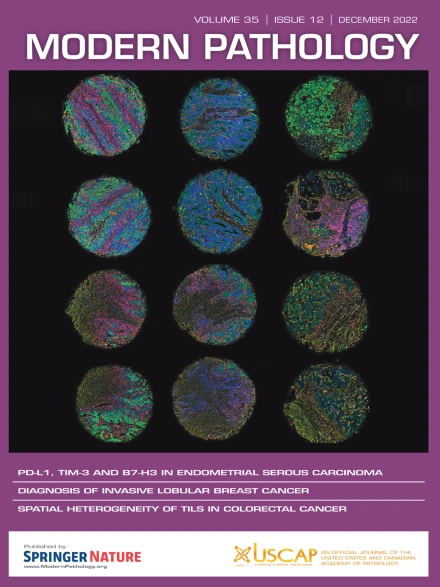原发性卵巢类癌的临床病理、免疫组织化学和分子分析以及Ki67增殖指数与患者预后的相关性。
IF 7.1
1区 医学
Q1 PATHOLOGY
引用次数: 0
摘要
原发性卵巢类癌(pOCT)是一种罕见的卵巢肿瘤,类似于发生在胃肠道的高分化神经内分泌肿瘤(NET)。与其他解剖部位的NETs不同,使用增殖标志物,如有丝分裂计数和Ki67增殖指数,在这些肿瘤的分类中尚未很好地建立。在这项研究中,我们描述了pOCTs的临床病理、免疫组织化学和分子特征,并将有丝分裂计数和Ki67指数与患者预后联系起来。在我们的23例poct中,大多数病例至少伴有一种其他卵巢肿瘤(19/23;82.6%),最常见的是成熟畸胎瘤或卵巢瘤(各43.5%;10/23)。23例(100%)表达synaptophysin, 87.0%(20/23)表达chromogranin。TTF-1和CDX2染色频繁(分别为33.3%和83.3%)。对14例患者进行了靶向外显子组测序,未发现复发性net相关突变或poct中新的突变。大多数poct表现为IA期疾病(13/23;56.5%),其中Ki67指数6例(46.2%;6/13)。IC期6例(26.0%),Ki67指数变化(1.2 ~ 35.6%)。卵巢外扩散4例(17.4%),Ki67指数3例(1.0% ~ 58.8%)。局部复发1例(4.3%),诊断时累及盆腔侧壁,Ki67指数为58.8%。随访时间为3至153个月(中位55.5个月),未发现疾病相关死亡。我们将我们的发现与先前发表的16例poct病例相结合,发现每2 mm2有20个有丝分裂的病例复发率最高。Ki67指数≥7.5%的患者总体生存期和无病生存期较差。总的来说,我们的研究结果重申了大多数poct的惰性性质,尽管疾病复发和侵袭行为可能发生,特别是在增殖指数升高的病例中。本文章由计算机程序翻译,如有差异,请以英文原文为准。
Clinicopathologic, Immunohistochemical, and Molecular Analysis of Primary Ovarian Carcinoid Tumors With Correlation of Ki67 Proliferation Index With Patient Outcomes
Primary ovarian carcinoid tumors (pOCTs) are a rare subset of ovarian neoplasms resembling well-differentiated neuroendocrine tumors (NETs) arising in the gastrointestinal tract. Unlike NETs at other anatomic sites, the use of proliferation markers, such as mitotic count and Ki67 proliferation index, is not well established in the classification of these tumors. In this study, we describe the clinicopathologic, immunohistochemical, and molecular characteristics of pOCTs and correlate mitotic count and Ki67 index with patient outcomes. In our series of 23 pOCTs, most cases were associated with at least 1 other ovarian neoplasm (19/23; 82.6%), most often a mature teratoma or struma ovarii (each 43.5%; 10/23). All 23 cases (100%) expressed synaptophysin, whereas 87.0% (20/23) expressed chromogranin. Frequent staining with TTF-1 and CDX2 (33.3% and 83.3%, respectively) was also observed. Targeted exome sequencing was performed in 14 cases, which identified no recurrent NET-associated mutations or novel mutations in pOCTs. Most pOCTs presented as stage IA disease (13/23; 56.5%), of which 6 had Ki67 indices >3% (46.2%; 6/13). There were 6 cases of stage IC disease (26.0%), which exhibited a variable Ki67 index (range: 1.2%-35.6%). Extraovarian spread was noted in 4 cases (17.4%), with 3 cases having Ki67 indices >3% (range: 1.0%-58.8%). Local recurrence occurred in 1 case (4.3%) with pelvic sidewall involvement at diagnosis and a Ki67 index of 58.8%. Follow-up, ranging from 3 to 153 months (median: 55.5 months), showed no disease-related deaths. We combined our findings with 16 previously published cases of pOCTs and found that cases with >20 mitoses per 2 mm2 had the highest rate of recurrence. Cases with Ki67 indices ≥ 7.5% were associated with worse overall and disease-free survival. Overall, our findings reaffirm the indolent nature of most pOCTs, although disease recurrence and aggressive behavior can occur, particularly in cases with elevated proliferation indices.
求助全文
通过发布文献求助,成功后即可免费获取论文全文。
去求助
来源期刊

Modern Pathology
医学-病理学
CiteScore
14.30
自引率
2.70%
发文量
174
审稿时长
18 days
期刊介绍:
Modern Pathology, an international journal under the ownership of The United States & Canadian Academy of Pathology (USCAP), serves as an authoritative platform for publishing top-tier clinical and translational research studies in pathology.
Original manuscripts are the primary focus of Modern Pathology, complemented by impactful editorials, reviews, and practice guidelines covering all facets of precision diagnostics in human pathology. The journal's scope includes advancements in molecular diagnostics and genomic classifications of diseases, breakthroughs in immune-oncology, computational science, applied bioinformatics, and digital pathology.
 求助内容:
求助内容: 应助结果提醒方式:
应助结果提醒方式:


